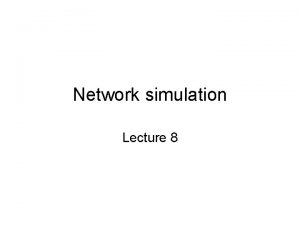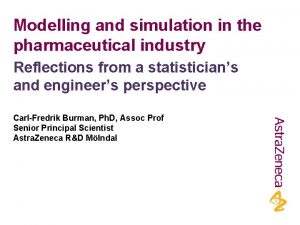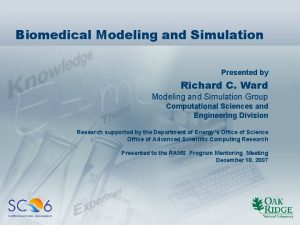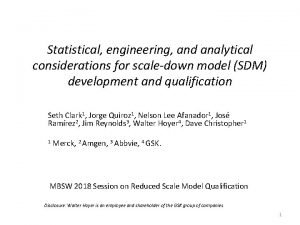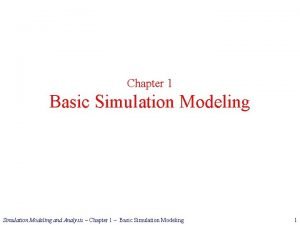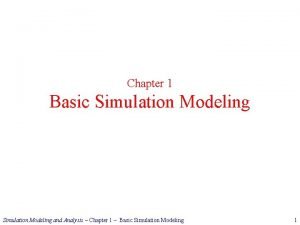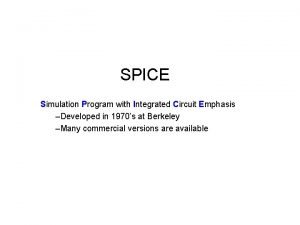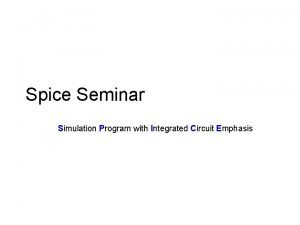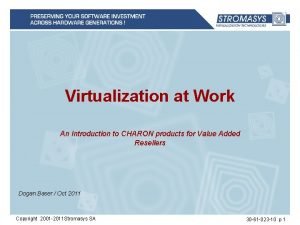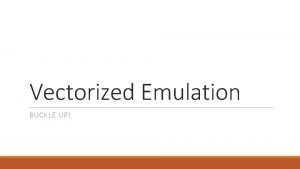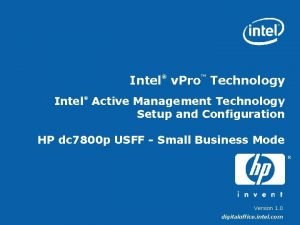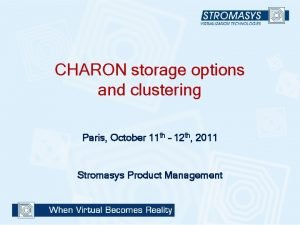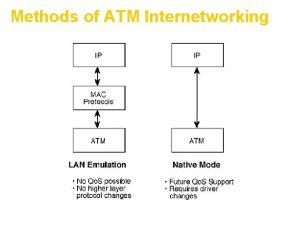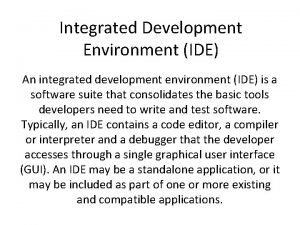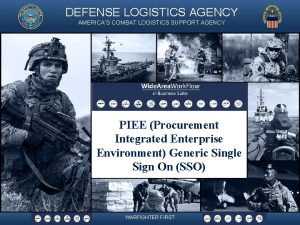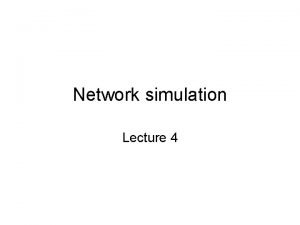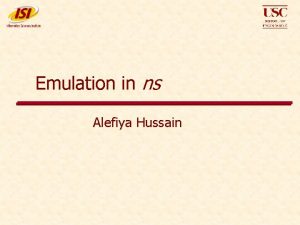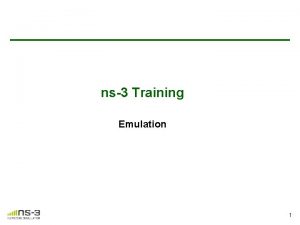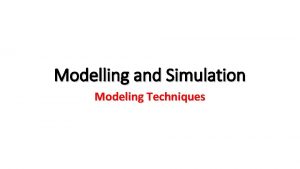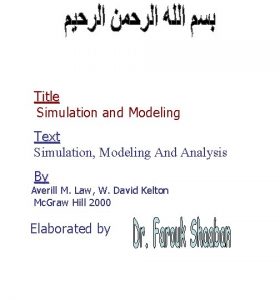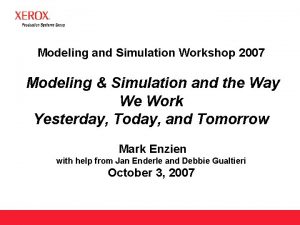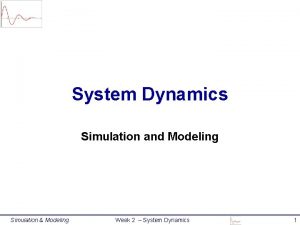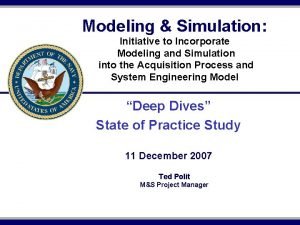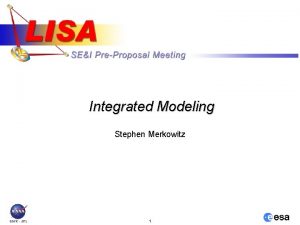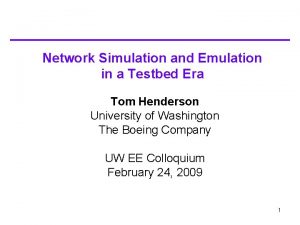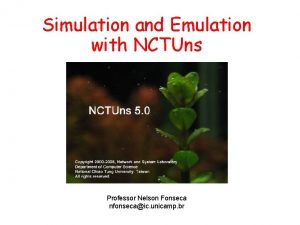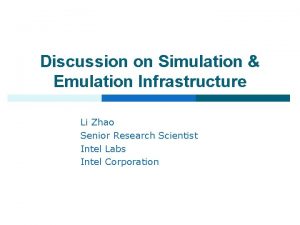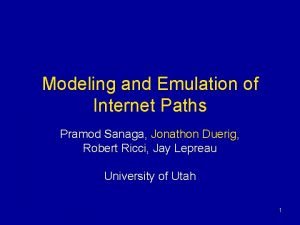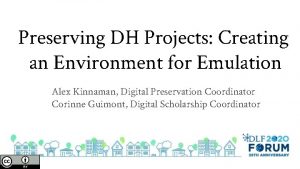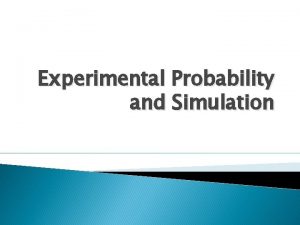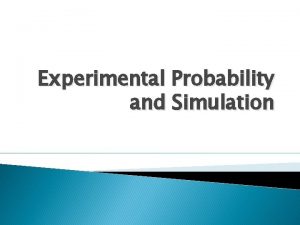Integrated Modeling Simulation and Emulation Environment for Security

























- Slides: 25

Integrated Modeling, Simulation and Emulation Environment for Security Assessment of Cyber-Physical Systems Yuan Xue Vanderbilt University

Cyber-Physical Systems Cyber-physical systems (CPS) are tight integrations of communications, computational and physical processes l l CPS has extraordinary significance for the future of the U. S. industry and military superiority. – A 2007 report of the President’s Council of Advisors on Science and Technology highlights CPS as the number one priority for federal investments in networking and information technology. Application Domains – Health-Care – Automotive Systems – Building and Process Controls – Defense and Aviation Systems – Critical Infrastructure

Security Issues of CPS l Trustworthiness of cyber‐physical systems is an essential concern l Formal analysis of CPS behavior is hard l There is a pressing need to evaluate both cyber- and physical systems together and holistically using simulation and/or emulation. 3

Need for Security Assessment Tool and Experiment Environment l Evaluation of CPS security requires a sophisticated modeling and simulation, experiment infrastructure – Realistic assessment – Early assessment – Automatic and rapidly configured experiments – Support for physical environment simulation – Support for convenient system measurement and holistic CPS behavior analysis. 4

Our Approach l Integration at two levels – Run-time: Integration of multiple tools/Environment l Simulation, emulation, real testbed so that they can interact in a coordinated way. – Modeling-time: Model integration l rapid configuration/deployment l Step I: Command Control Wind Tunnel – Heterogeneous simulation integration Step II, Integration of Deter. Lab and C 2 WT – Simulation and emulation integration l

C 2 Wind Tunnel l Integration of multiple simulation tools – l Matlab/Simulink, OMNe. T++, DEVSJAVA, Delta 3 D, CPN, etc. Follow HLA standard – Coordinate execution of distributed simulations via RTI Simulation Tools -Simulink -Omnet -DEVSJAVA -OGRE -CPN Tools -Java/C/C++ -etc. Passive Federates -Data loggers -Monitors -Analysis -Prognostics -Projections Live components -UAVs -Command & Control -Live deployment feedback C 2 Wind Tunnel Integration Framework Run-Time Infrastructure (RTI)

C 2 Wind Tunnel l Model-integrated approach – – Develop an overarching modeling environment based on GME Integrate different platform-specific simulation models

From Simulation to Emulation l l l Network components and policies are essential aspects of CPS The impact of network on CPS system need to be accurately characterized – Think about the network attacks… Limit of network simulator – Protocol implementation details are missing – Poor scalability Network simulation is insufficient in providing the level of accuracy required by the evaluation of CPS.

From Simulation to Emulation l l Benefit of network emulation – Greater realism and accuracy with truthful protocol implementation and real network traffic delivery – Providing a computing platform where prototypes of software components can be deployed Network emulation platform – Emulab – DETERNet l Tools available for emulate network attacks

Architecture Experiment Specification Model Integration Layer Network Models Network Applications Controller Models Emulation Federate Simulation. Emulation Tunnel Simulink Federate Organization Models Environment Models CPN Federate Delta 3 D Federate Fusion Models Model Run-time DEVS Federate Run-Time Infrastructure (RTI) Data communication Layer (TCP/IP) Emulation Platform Simulation Platform Emulab

Design Consideration l Communication between simulated objects and real network objects l Time synchronization between simulated objects and real network objects

Meta-Model and Models l l l Network Topology Model Network Application Process Deployment and Communication Model Network Interaction Model

Meta-Model for Network Topology

Topology Model UAV 1 11 M bps wireless link Access Point 10 M bps Control Station UAV 2 11 M bps wireless link Bandwidth: 11 Mbps Loss: 0. 01 Delay: 20 ms Bandwidth: 2 Mbps Loss: 0. 2 Delay: 20 ms Capacity: 11 Mbps Propagation Model: Free space MAC: IEEE 802. 11 Bandwidth: 10 Mbps Delay: 10 ms Loss: 0. 02

Deployment Meta. Model

Deployment Model Example UAV 1 Send. Image Recv. Command UDP TCP UDP UAV 2 Send. Image Recv. Command TCP Control. Station Recv. Image Send. Command

Network Interaction Meta. Model

Send. Image. To. Network Node. Name: TBD (UAV 1) Proc. Name: Send. Image Timestamp: TBD Parameter: Image. URL (String): Recv. Image. From. Network Node. Name: TBD (Control. Station) Proc. Name: Recv. Image Timestamp: TBD Peer. Node. Name: TBD (UAV 1) Peer. Proc. Port: TBD Parameter: Packet. Delay(double) Recv. Command. From. Network Node. Name: TBD (UAV 1) Proc. Name: Recv. Command Timestamp: TBD Peer. Node. Name: TBD (Control. Station) Peer. Proc. Port: TBD Parameter: Command (String) Send. Command. To. Network Node. Name: TBD (Controal. Station) Proc. Name: Send. Command Timestamp: TBD Parameter: Command (String)

Modeling Environment Model Interpreter Run-Time Environment C 2 WT Simulation Environment RTI Network Interaction Model Emu. Gateway Federate Simulink Federate … Tap Server Deployment Model Host Assignment Tap Client Federates Involving network communication Tap Client Network Application Code Network File System Topology Model TCL script Configuration/Control Environment Deterlab Emulation Environment …

Emulation Host for UAV 1 Host. Map Recv. Command TCP UDP Send. Image Tap Client Emulation Host for Control. Station Time converter Host. Map Send. Command Recv. Image Tap Client Time converter Task buffer Emulation Env Interaction Delivery Protocol Host. Map Node. Name: Host. IP UAV federate Tap Server Local. Task buffer Emu. Gateway federate Simulation Env Interaction Handler RTI Control. Station federate

21

Our Experiment Setup Simulated Applications UAV Sim* • Simulink Network Object Deterlab Network Object Physics Simulation • Delta 3 D

Finally, a short demo

Acknowledgement l NSF TRUST NSF SDCI l C 2 WT team at Vanderbilt l – l Gabor Karsai, Janos Sztipanovits, Himanshu Neema Collaborators from AFRL – Timothy Busch 24

Thank you Questions? 25
 Simulation vs emulation
Simulation vs emulation Electronic commerce security
Electronic commerce security Role modeling theory
Role modeling theory Simulation kelton
Simulation kelton Pharmaceutical simulation and modeling
Pharmaceutical simulation and modeling Introduction to modeling and simulation
Introduction to modeling and simulation Biomedical modeling and simulation
Biomedical modeling and simulation Simulasi
Simulasi Site:slidetodoc.com
Site:slidetodoc.com Dimensional modeling vs relational modeling
Dimensional modeling vs relational modeling Private secuirty
Private secuirty Basic simulation modeling
Basic simulation modeling Basic simulation modeling
Basic simulation modeling Spice (simulation program with integrated circuit emphasis)
Spice (simulation program with integrated circuit emphasis) M u n p f
M u n p f Charon axp plus virtualization
Charon axp plus virtualization Vectorized emulation
Vectorized emulation Pruvix
Pruvix Emulate charon axp
Emulate charon axp Target trial emulation
Target trial emulation Lan emulation
Lan emulation Define integrated development environment
Define integrated development environment Procurement integrated enterprise environment
Procurement integrated enterprise environment Arduino development environment
Arduino development environment Integrated award environment
Integrated award environment Financial environment in business environment
Financial environment in business environment
